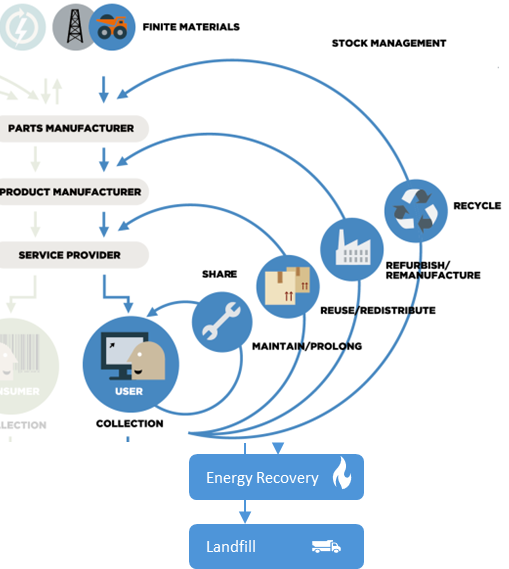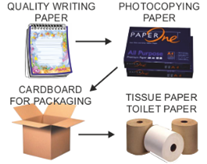Unless you are an avid anthropologist who enjoys sorting through an excavated landfill to find clues about the everyday life of ancient civilizations, waste is probably not a primary interest of yours. However, this is beginning to change as landfills are increasingly identified as sources of soil and water contamination and methane gas emissions, a potent greenhouse gas contributing to climate change. Protecting ecosystems and biodiversity is another key concern, and reducing waste helps mitigate the environmental impacts of raw materials extraction and pollution. These concerns are taking center stage as customers and investors advocate for companies to take action. Waste reduction strategies ultimately involve rethinking our approach to systems of production and consumption.
Waste and the Circular Economy
The term “circular economy” is becoming more mainstream and ubiquitous, with waste reduction being a critical component of this closed-loop system. In a circular economy, resources are continuously reused, refurbished, and recycled, minimizing waste and the consumption of finite resources. A linear economy follows a traditional “take, make, and dispose” model beginning with the extraction of natural resources and ending with waste going to landfills. This approach contrasts with a circular economy where resources, materials, and products are reintroduced back into various stages of the value chain through an interconnected system, enabling maximum value to be extracted before recovering and repurposing products at the end of their useful life.

Another way to think of the circular economy is through the lens of a life cycle analysis (LCA) but with the focus on feedback loops for reintegration within the production process. The following diagram, created by the Ellen MacArthur foundation, illustrates various feedback loops within the durable goods production process (e.g. technical cycle) as pathways for maintenance, reuse, refurbishing, and recycling. In another post, I will address the agriculture and food production process (biological cycle). Understanding the opportunities within these pathways is critical to navigating waste reduction strategies within the circular economy model.

Product Transformation – A Second, Third, or Fourth Life

Beyond these feedback loops, products can also be repurposed by transformation into other lower-value uses, a process known as downcycling. Downcycling is the process of converting end-of-life products into new materials or products of lesser quality. For example, used plastic bottles can be used to make fleece or carpet fiber, and used writing/printing paper can be converted into packaging carboard or tissue paper. This conversion extends the life of these products by redirecting them to subsequent value chains before arriving at the final stage of waste-to-energy conversion through incineration or transportation to a landfill.
Practical Solutions and Strategies
The renowned author Steven R. Covey, author of 7 Habits of Highly Effective People, probably had no idea that his second habit, “Begin with the End in Mind”, would have so much relevance to the circular economy. Envisioning pathways for how end-of-life products can be reintegrated back into the value chain elicits a paradigm shift the way a product is designed, manufactured, and packaged. Careful planning of how a product can be maintained, reused, refurbished, and recycled at the end of its useful life is the first step in establishing a circular economy mindset. These approaches include:
- Redesign: A focus on expanding longevity, repairability, and recyclability so products can be easily disassembled, and components reused or recycled
- Reduce: Optimize resource use by driving efficient production processes
- Reuse: Extend the life of products through repair, refurbishment, and remanufacturing, reducing the need for new materials and lowering overall waste generation
- Recycle: Transforms end-of-life products and waste into valuable resources. This includes setting up systems, education, outreach, and technology investment
Other solutions and strategies include conducting a waste audit to identify hotspots requiring attention, implementing a take-back program for products and packaging, and investment in advanced recycling facilities. Engaging customers, employees, and suppliers plays an influential role in developing a culture of sustainability and commitment to successful implementation of waste reduction initiatives.
Challenges and Solutions
The merits of waste reduction by following guiding principles of the circular economy seem logical and straightforward, but various challenges remain. Initial upfront costs can be a barrier, but seeking grants, subsidies, and partnerships can help offset these expenses. Changing existing processes and systems to incorporate waste reduction practices can operationally challenging. Pilot projects, implementation processes, and employee training programs can facilitate this transition. Ensuring supplier compliance with waste reduction standards requires strong relationships and incorporating sustainability criteria into the procurement processes. Influencing consumer behavior toward reducing waste can be difficult, but educational campaigns and incentives can encourage sustainable consumption.
Financial Benefits
While the environmental benefits of waste reduction are clear, it is important to clearly articulate the financial benefits of investments in waste reduction initiatives. These benefits include lower disposal fees from reduced waste volume, potential revenue from recycled materials, enhanced resilience and competitiveness by reducing dependency on finite resources, mitigation of supply chain risks, enhanced brand reputation, and lower risk of potential fines or penalties from regulatory non-compliance.
Summary and Conclusions
Integrating waste reduction strategies using principles of the circular economy is essential for achieving sustainability goals. By focusing on reducing, reusing, and redesigning products and materials, companies can create closed-loop systems that minimize waste, conserve resources, and deliver significant environmental and financial benefits (e.g. cost savings, new revenue streams, and enhanced brand reputation). Embracing the circular economy not only helps to address global sustainability challenges but also enhances business resilience and long-term profitability. For guidance on implementing these practices effectively, contact Canopy Edge to navigate the complexities of reducing waste.


